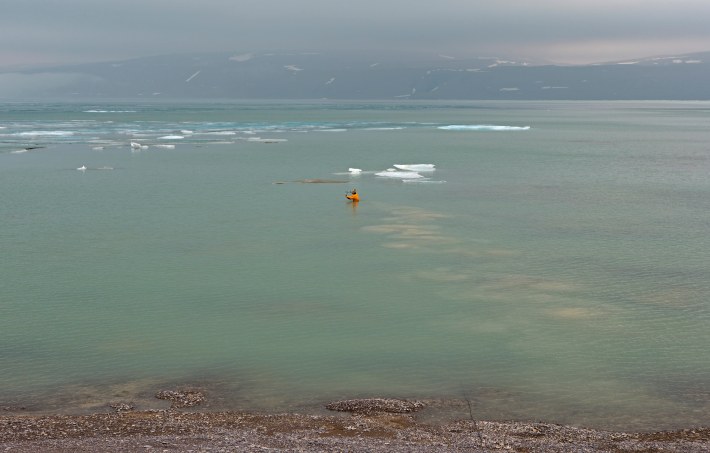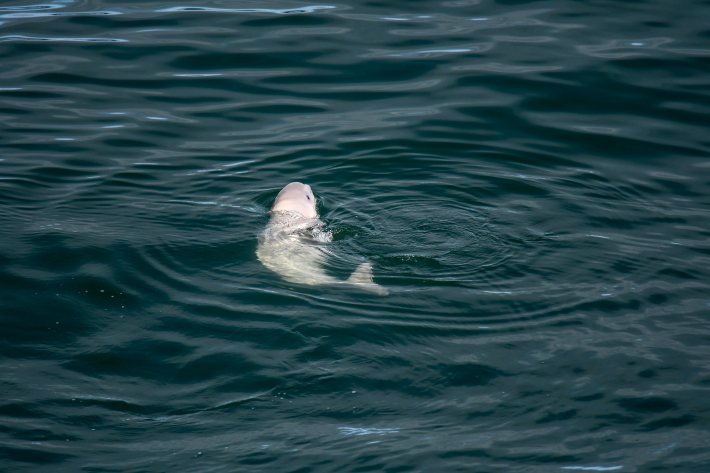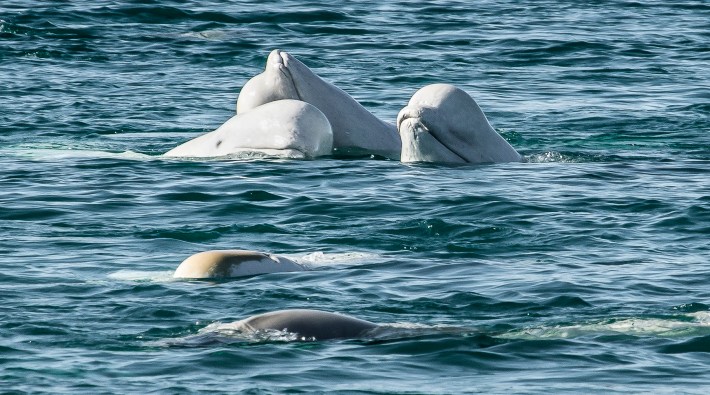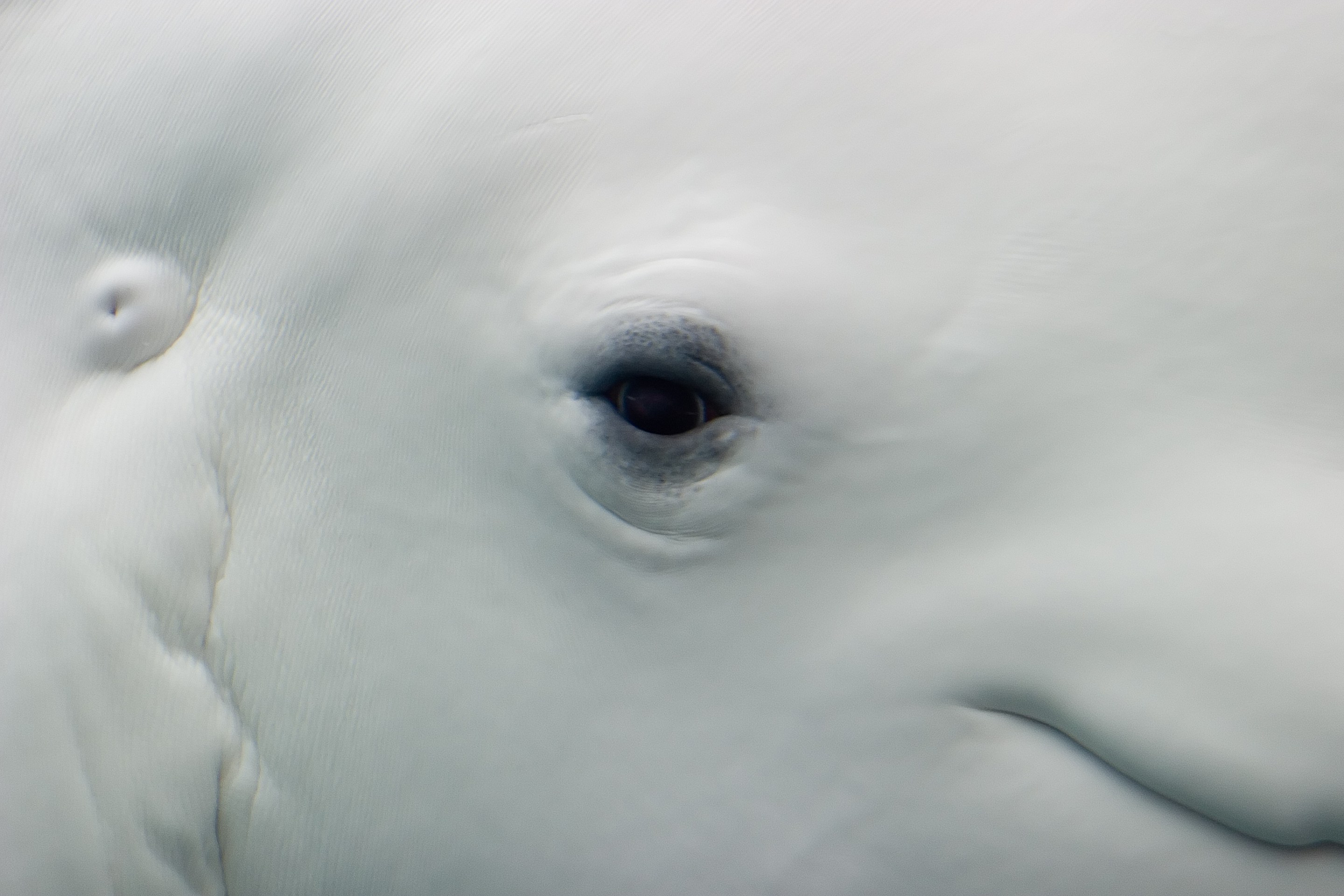In 2012, future First Lady Melania Trump tweeted a photo of the smiling face of a beluga whale accompanied by the text: “What is she thinking?” This question, however unsettling its speaker or baffling its context, was a good one, and not without precedent. It’s clear animals think, often in ways that recall our own intelligence; crows use tools to extract termites and Japanese macaques salt their sweet potatoes in the ocean. Although my investigation led me to the identity and life story of the particular beluga whale in Melania's photo, a whale whose life was uniquely well-documented compared to other beluga whales and who likely thought about us as well, I still do not know exactly what this whale was thinking. This larger question may always remain beyond our grasp.
What is she thinking? pic.twitter.com/rFufrgMb
— MELANIA TRUMP (@MELANIATRUMP) August 10, 2012
This problem of the unknowable animal mind is famously articulated by the philosopher Thomas Nagel in his 1974 essay "What Is It Like to Be a Bat?" Although the essay is technically more concerned with the subjectivity of consciousness than it is with actually investigating what it is like to be a bat, it argues that our own specifically human experience of the world precludes us from understanding life as a bat—a creature with poor vision but a spectacular understanding of the world through echoes. No matter how deeply we study the frequencies involved in bat echolocation, the mechanics of bat flight, or even the energetics of dangling upside-down for a really long time, we will never be able to perceive the world the way a bat does.
But forget bats. What does a beluga think about? "It's what we all want to know," said Valeria Vergara, senior scientist at the Raincoast Conservation Foundation. "By 'we' I mean the people who want to devote their lives to studying these animals." (And Melania.)
Kristin Westdal, science director at the conservation organization Oceans North, suggested, in broad strokes, that belugas think about some of the same things that we do. "They're thinking about food. They're thinking about mating. They're thinking about socializing," she said.
However, the intricacies of these thoughts, and the perceptual world of belugas, still elude us. "Because we're also mammals, and we're also social, and we're also intelligent, we can get hints at how their mind might work," Vergara said. "But I just can't even begin to imagine what it might be like to, you know, be in an aquatic environment, rely on sounds instead of vision, navigate in the dark, know who you're surrounded by."
There may be no whale as unmistakable as a beluga—a body as alabaster as veneers, skin as squeaky as a cheese curd, and the most infectious smile you could hope to find underwater. The whales live around the world in Arctic and sub-Arctic waters, where the sun disappears for half the year and shrouds the ocean in utter darkness. This polar habitat means the whales need to locate distant breathing holes while trapped under vast expanses of ice. So a beluga's world is shaped by sound, aided by the fatty blob on their head, or melon. Belugas wiggle their melons to change or direct the frequencies of their sound waves and refine their echolocation.
Like other whales, belugas are social creatures. A 2020 paper published in the journal Scientific Reports found the whales live in a number of complex societies, forming communities anywhere from two to 10 individuals to herds of thousands. The whales navigate thousands of miles in these groups by communicating with each other; "the glue of that society is sound," Vergara said.

"I do believe that studying sounds does give us a window into their minds," Vergara added. Her research offers preliminary evidence that the whales each possess a vocal signature: a unique call that functions like a name tag, allowing belugas to announce and identify themselves beyond the sounds of their voices. "It's the same difference as if I said, 'Hey' or if I said to you, 'Hey, Valeria coming!'" Vergara said, adding that the frequency components of a voice change at depth with water pressure. "So you need something much more emphatic than a voice, and that's a name."
A naming system suggests that belugas have a referential capacity that allows them to think of other individual belugas and manage their social relationships. Name-like calls are rare in the animal kingdom, Jane C. Hu wrote in a story for Nautilus. But these signals have emerged in very different animals, including African elephants, orange-fronted parakeets and bottlenose dolphins.
Vergara has studied belugas in bays and estuaries in Canada, as well as around the Arctic Archipelago. In the industrialized St. Lawrence Estuary, an endangered population of belugas swims alongside shipping vessels. Here, vessel traffic can get so loud that newborn belugas with softer calls may not be heard by their mothers from a few hundred yards away—a regular separation that occurs as mothers dive deep to feed and calves wait at the surface.

Further north, belugas enjoy quieter, wilder seas. When Vergara dropped a hydrophone to record the whales on the north end of Somerset Island, an uninhabited island in the archipelago and a summer nursery for belugas, she heard a cacophony of sounds—chirps, whistles, squawks, barks, and buzzes. "On any given day you can have a thousand belugas surrounding you," Vergara said. "It's as if you were walking into a tropical jungle full of birds, it's so deafening and complex."
Years ago, Westdal led guided kayak tours for beluga-watching by Churchill, Manitoba, where she could hear the belugas calling from the surface of the water and feel their vibrations thrumming through the thin plastic of the kayak. The belugas in the Churchill estuary were always curious around boats, Westdal said, adding they would approach her kayak in just a few minutes, rubbing up against her plastic and lifting the vessel up. One time, a beluga pulled out a pin that connected Westdal's rudder. "The whole rudder system fell off," she said. "They love poking around to see things hanging off the boat, and looking for things to play with." So belugas think about pleasure, too.
But whales are not a monolith and I had still not answered Melania's specific question—what was this particular beluga whale thinking about? Unsurprisingly, the original tweet failed to credit a photographer and offered no clear context into the identity of this particular beluga whale. How had Melania encountered this photo? Just as Nagel imagined having webbing on his arms and catching insects in his mouth, I imagined taking out my unsheathed iPhone as my husband screamed distantly on the lawn, opening Google Images, and scrolling through the photos that appeared. However much I tried, I knew I could not fully understand what it was like for Melania to be Melania.
Perhaps I needed to think less like Melania and more like a journalist. When I reverse-image searched the photo in Google, I came across an online story from 2005 in the German newsmagazine Der Spiegel. The story—more accurately a slideshow—alleged that U.S. military–trained dolphins had escaped amid the wreckage of Hurricane Katrina. The beluga photo was accompanied by a caption ("The U.S. Navy not only uses dolphins, but also sea lions and small whales like this one. Many of them have been trained to use toxic darts against underwater terrorists.") and a credit: Space and Naval Warfare Systems Center San Diego. Was the whale from Melania's tweet a troop?
I emailed the Naval Information Warfare Center Pacific, which manages the marine mammal program, to find out. After a few of my emails bounced, NIWCP spokesperson Darian Wilson responded. "In regards to your question, yes, that’s a picture of our Navy male beluga whale, No-see-um, also known as No See, and sometimes abbreviated NOC, when he was a young adult," Wilson wrote in an email. So not only was the beautiful, glossy beluga from the photo a part of the U.S. Navy, but also the whale was a male. So if we can't answer Melania we can at least correct her question: What was he thinking?
NOC (pronounced no-see) was legally captured from waters off the northern coast of Manitoba in 1977—one of six belugas taken for the Navy's ongoing deployment of marine mammals for tasks including mine detection and recovery of experimental torpedoes, according to a Smithsonian profile of the whale's life. Two-year-old NOC, the smallest beluga of the bunch, was named after tiny biting midges known as "no-see-ums." He learned all the skills Navy dolphins and sea lions acquire. But bulky belugas were more difficult to work with than svelter bottlenoses, and so NOC was eventually reassigned to the navy's research program, Wilson said.
After seven years of living in captivity in San Diego Bay, NOC began imitating human speech. Although NOC lived with two older whales, NOC was the only human mimic, and he never made these noises when interacting with other whales. NOC's impressions were skilled; once, a diver surfaced from his tank and asked "Who told me to get out?" before realizing the speaker was a whale.
In a paper published in Current Biology in 2012, the researchers working with NOC published a paper analyzing the whale's human-like vocalizations, which were several octaves lower than his normal whale calls. NOC made these noises by over-inflating the nasal cavities inside his melon. He could then manipulate these sounds by adjusting the shape of his "phonic lips," which vibrate above each nasal cavity. The authors of the paper downplayed NOC's skill as a vocalist. "We do not claim that our whale was a good mimic compared to such well-known mimics as parrots or mynah birds," they wrote. (An accidental, informal poll of all two of the Defector staff members present in the office concluded that NOC's vocalizations did indeed sound human.)
What might NOC have been thinking? The whale himself is long gone, having died of meningitis in 1999 at the age of 23 (in the wild, belugas can live to around 60 or 70 years, according to some estimates). We can speculate what NOC may have been thinking, or trying to say. Presumably he thought of his trainers or the muffled human conversations he overheard that led to his impressions. Possibly he thought of the dolphins or two female belugas with whom he shared an enclosure. No doubt he thought of food, or mating, or any of the other fundamental needs that make up a life. Or perhaps none of this is right. We can never entirely know the experience of another being, whale or human. We all experience things differently—darkness, cold, vibrations, the ocean, a squid.

Whatever NOC's human impressions meant to the whale—a mockery of us, a plea for connection, a performance, or a simple way to pass the time—listening to the old recording felt strange and sad to me, a reminder of the enormous gulf between us. When I scoured the web for more details about NOC's life, I came across a paper describing one summer evening when NOC was 13 years old and he and two other belugas were being held in a netted enclosure in San Diego Bay. The whales were watching three dense, silvery schools of anchovies swimming just beyond the net, feasting on plankton in the soft glow of the pier lights. About an hour past sunset, NOC and another whale flipped over on their backs, and lunged toward the anchovies with their net stretched over their open mouths. When manipulated this way, the net trapped bagfuls of anchovies at the surface of the water that NOC and the other whale sucked in again and again and again. The two whales guzzled anchovies for nearly an hour, until the schools had been all but consumed. The researchers observing this impromptu feast dropped a hydrophone into the water and heard a slow, constant clicking sound that escalated into a bright, buzzing noise coinciding with every gulpful of fish. The sound was a "victory squeal" that dolphins and belugas emit after eating, like the celebration of a giddy child. It seems that NOC and the other beluga were experiencing pleasure, or something like it, reveling in the joy of a tasty fish or the delight of hacking their enclosure to reap an anchovy buffet—or maybe that's just what we think.





